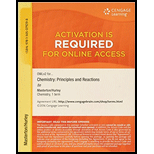
CHEMISTRY:PRIN.+REACTIONS-OWLV2 ACCESS
8th Edition
ISBN: 9781305079298
Author: Masterton
Publisher: Cengage Learning
expand_more
expand_more
format_list_bulleted
Question
Chapter 23, Problem 40QAP
Interpretation Introduction
Interpretation:
The sketch of the polymer obtained from head to head, tail to tail and head to tail combination of acrylonitrile needs to be drawn.
Concept Introduction:
A polymer is a long chain consists of large number of monomer units. The monomers are repeated units in a polymer they are linked to each other in different orders to produce different
These monomer units are linked to each other either through the formation of peptide linkage or glycosidic linkage or by removal of any moiety such as a water molecule.
Polyvinyl chloride, bakelite, polystyrene are some of the example of polymers.
Expert Solution & Answer
Want to see the full answer?
Check out a sample textbook solution
Students have asked these similar questions
For the titration of a divalent metal ion (M2+) with EDTA, the stoichiometry of the reaction is typically:
1:1 (one mole of EDTA per mole of metal ion)
2:1 (two moles of EDTA per mole of metal ion)
1:2 (one mole of EDTA per two moles of metal ion)
None of the above
Please help me solve this reaction.
Indicate the products obtained by mixing 2,2-dimethylpropanal with acetaldehyde and sodium ethoxide in ethanol.
Chapter 23 Solutions
CHEMISTRY:PRIN.+REACTIONS-OWLV2 ACCESS
Ch. 23 - Prob. 1QAPCh. 23 - Prob. 2QAPCh. 23 - Prob. 3QAPCh. 23 - Prob. 4QAPCh. 23 - Prob. 5QAPCh. 23 - Prob. 6QAPCh. 23 - Prob. 7QAPCh. 23 - Prob. 8QAPCh. 23 - Prob. 9QAPCh. 23 - Prob. 10QAP
Ch. 23 - Prob. 11QAPCh. 23 - Prob. 12QAPCh. 23 - Prob. 13QAPCh. 23 - Prob. 14QAPCh. 23 - Prob. 15QAPCh. 23 - Prob. 16QAPCh. 23 - Prob. 17QAPCh. 23 - Prob. 18QAPCh. 23 - Prob. 19QAPCh. 23 - Prob. 20QAPCh. 23 - How many chiral carbon atoms are there in ...Ch. 23 - How many chiral carbon atoms are there in sucrose?...Ch. 23 - Prob. 23QAPCh. 23 - Give the structural formulas of two different...Ch. 23 - (a) How many tripeptides can be made from glycine,...Ch. 23 - Prob. 26QAPCh. 23 - Prob. 27QAPCh. 23 - Prob. 28QAPCh. 23 - For alanine, Ka1=5.1105,Ka2=1.81010 . Calculate...Ch. 23 - Prob. 30QAPCh. 23 - On complete hydrolysis, a polypeptide gives two...Ch. 23 - Prob. 32QAPCh. 23 - Prob. 33QAPCh. 23 - Prob. 34QAPCh. 23 - Prob. 35QAPCh. 23 - Prob. 36QAPCh. 23 - Prob. 37QAPCh. 23 - Prob. 38QAPCh. 23 - Prob. 39QAPCh. 23 - Prob. 40QAPCh. 23 - Prob. 41QAPCh. 23 - Sketch the form in which leucine would exist in...Ch. 23 - How many tripeptides could one make from glycine,...Ch. 23 - A 1.00-mg sample of a pure protein yielded on...Ch. 23 - Describe what is meant by (a) the primary...Ch. 23 - Glycolysis is the process by which glucose is...Ch. 23 - Plants synthesize carbohydrates from CO2 and H2O...Ch. 23 - Prob. 48QAPCh. 23 - Prob. 49QAPCh. 23 - Prob. 50QAPCh. 23 - Prob. 51QAPCh. 23 - Aspartic acid acts as a triprotic acid with...
Knowledge Booster
Similar questions
- Synthesize 2-Ethyl-3-methyloxirane from dimethyl(propyl)sulfonium iodide using the necessary organic or inorganic reagents. Draw the structures of the compounds.arrow_forwardSynthesize 2-Hydroxy-2-phenylacetonitrile from phenylmethanol using the necessary organic or inorganic reagents. Draw the structures of the compounds.arrow_forwardSynthesize N-Methylcyclohexylamine from cyclohexanol using the necessary organic or inorganic reagents. Draw the structures of the compounds.arrow_forward
- Synthesize N-Methylcyclohexylamine from cyclohexanol using the necessary organic or inorganic reagents. Draw the structures of the compounds.arrow_forwardIf possible, please provide the formula of the compound 3,3-dimethylbut-2-enal.arrow_forwardSynthesize 1,4-dibromobenzene from acetanilide (N-phenylacetamide) using the necessary organic or inorganic reagents. Draw the structures of the compounds.arrow_forward
- Indicate the products obtained by mixing (3-oxo-3-phenylpropyl)triphenylphosphonium bromide with sodium hydride.arrow_forwardWe mix N-ethyl-2-hexanamine with excess methyl iodide and followed by heating with aqueous Ag2O. Indicate the major products obtained.arrow_forwardIndicate the products obtained by mixing acetophenone with iodine and NaOH.arrow_forward
- Indicate the products obtained by mixing 2-Propanone and ethyllithium and performing a subsequent acid hydrolysis.arrow_forwardIndicate the products obtained if (E)-2-butenal and 3-oxo-butanenitrile are mixed with sodium ethoxide in ethanol.arrow_forwardQuestion 3 (4 points), Draw a full arrow-pushing mechanism for the following reaction Please draw all structures clearly. Note that this intramolecular cyclization is analogous to the mechanism for halohydrin formation. COH Br + HBr Brarrow_forward
arrow_back_ios
SEE MORE QUESTIONS
arrow_forward_ios
Recommended textbooks for you
 Chemistry: Principles and ReactionsChemistryISBN:9781305079373Author:William L. Masterton, Cecile N. HurleyPublisher:Cengage Learning
Chemistry: Principles and ReactionsChemistryISBN:9781305079373Author:William L. Masterton, Cecile N. HurleyPublisher:Cengage Learning Chemistry: Principles and PracticeChemistryISBN:9780534420123Author:Daniel L. Reger, Scott R. Goode, David W. Ball, Edward MercerPublisher:Cengage Learning
Chemistry: Principles and PracticeChemistryISBN:9780534420123Author:Daniel L. Reger, Scott R. Goode, David W. Ball, Edward MercerPublisher:Cengage Learning Principles of Modern ChemistryChemistryISBN:9781305079113Author:David W. Oxtoby, H. Pat Gillis, Laurie J. ButlerPublisher:Cengage Learning
Principles of Modern ChemistryChemistryISBN:9781305079113Author:David W. Oxtoby, H. Pat Gillis, Laurie J. ButlerPublisher:Cengage Learning Chemistry: The Molecular ScienceChemistryISBN:9781285199047Author:John W. Moore, Conrad L. StanitskiPublisher:Cengage Learning
Chemistry: The Molecular ScienceChemistryISBN:9781285199047Author:John W. Moore, Conrad L. StanitskiPublisher:Cengage Learning World of Chemistry, 3rd editionChemistryISBN:9781133109655Author:Steven S. Zumdahl, Susan L. Zumdahl, Donald J. DeCostePublisher:Brooks / Cole / Cengage Learning
World of Chemistry, 3rd editionChemistryISBN:9781133109655Author:Steven S. Zumdahl, Susan L. Zumdahl, Donald J. DeCostePublisher:Brooks / Cole / Cengage Learning Introductory Chemistry: An Active Learning Approa...ChemistryISBN:9781305079250Author:Mark S. Cracolice, Ed PetersPublisher:Cengage Learning
Introductory Chemistry: An Active Learning Approa...ChemistryISBN:9781305079250Author:Mark S. Cracolice, Ed PetersPublisher:Cengage Learning

Chemistry: Principles and Reactions
Chemistry
ISBN:9781305079373
Author:William L. Masterton, Cecile N. Hurley
Publisher:Cengage Learning

Chemistry: Principles and Practice
Chemistry
ISBN:9780534420123
Author:Daniel L. Reger, Scott R. Goode, David W. Ball, Edward Mercer
Publisher:Cengage Learning

Principles of Modern Chemistry
Chemistry
ISBN:9781305079113
Author:David W. Oxtoby, H. Pat Gillis, Laurie J. Butler
Publisher:Cengage Learning

Chemistry: The Molecular Science
Chemistry
ISBN:9781285199047
Author:John W. Moore, Conrad L. Stanitski
Publisher:Cengage Learning

World of Chemistry, 3rd edition
Chemistry
ISBN:9781133109655
Author:Steven S. Zumdahl, Susan L. Zumdahl, Donald J. DeCoste
Publisher:Brooks / Cole / Cengage Learning

Introductory Chemistry: An Active Learning Approa...
Chemistry
ISBN:9781305079250
Author:Mark S. Cracolice, Ed Peters
Publisher:Cengage Learning